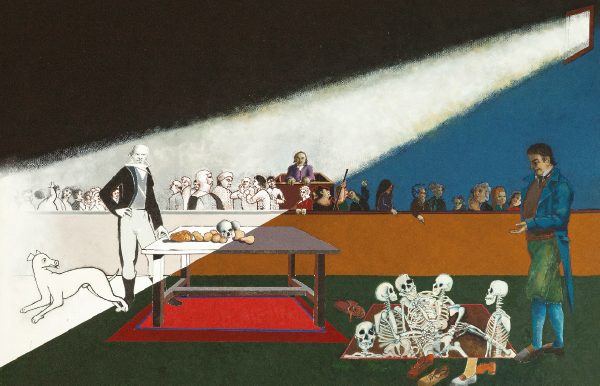By Kathrin Kobus

Black 47 (1997-8) by William Farrell. Image Courtesy of Quinnipiac University.
Art and the Great Famine has come to Ireland. Quinnipiac University, Connecticut is home of Ireland’s Great Hunger Museum. Now, for the very first time its collection has travelled eastwards over the ocean and found a temporary home in The Coach House at Dublin Castle until June this year.
While most of the exhibits are paintings, there are also bronze sculptures and installations with an array of Irish and Irish-American artists represented. Among them are Jack B. Yeats, Dorothy Cross, Paul Henry, William Crozier, John Behan, Brian Maguire, Rowan Gillespie, Michael Farrell, Hughie O’Donoghue and Alanna O’Kelly.
The exhibition encompasses a time frame of nearly two hundred years, from early 1830 to the present day, like the new painting by Robert Ballagh which was unveiled as the latest part added to the collection.
For John H. Lahey, the president of Quinnipiac University it was a memorable home coming: “My great grandparents had made the journey in the other direction – in 1876 they emigrated to America. So I feel very moved, emotionally, to be here today. It has always been our goal to bring this outstanding collection home to Ireland; now that day has arrived. To have the President of Ireland, Michael D. Higgins launch ‘Coming Home: Art and the Great Hunger’ at Dublin Castle is not only humbling, it is testament to the cultural and historical significance of this collection to the Irish people.”
It was twenty years ago, back in 1998 that the idea for this collection began to take shape. President Michael D. Higgins has been a supporter of the project since the very beginning. He expressed that in his preface to the exhibition catalogue, “An Gorta Mór was a defining moment in the history of modern Ireland and a turning point in the history of our people… Today, we are fortunate to have a great body of scholarship that adds to our understanding of that tragic chapter of our history and provides us with material for reflection, understanding, and, indeed, resolution.”
A variety of talks and lectures, children’s workshops, panel discussions, literature and music performances are centred around the exhibition, including a short film commissioned especially for the younger generation, The Hunger Times which had its official premiere on March 21st, shown together with the big-screen feature Black ‘47 at the Irish Film Institute.
The curator Niamh O’Sullivan will take visitors on a guided tour of it on 9th of May.
In her words: “The Famine continues to exert its hold on Ireland and its diaspora. Artists, uniquely perhaps, are equipped to express the complexity of our relationship with our past, and to explore the continuum of poverty and displacement, as well as issues of class and identity in our contemporary world.”
Coming Home offers guests and visitors different views of landscapes and glimpses into ways of life long gone. The exhibition invites us to pause and reflect on what connects and separates us from those who lived and suffered 200 years ago. Ringsenders should especially look out for the Rag Pickers painting by Henry Allan, which depicts two women who scavenge for waste materials on the dunes of Ringsend, to discover how the area has changed.
After Dublin, the exhibition will journey south to the Uillinn: West Cork Arts Centre in Skibbereen, followed by the Culturlann Ui Chanain An tSeaneaglais (Glassworks) in Derry for its last port of call beginning January 2019
Art and the Great Hunger is open to the public daily from 10 am till 5 pm at The Coach House, Dublin Castle.
For further information regarding events visit www.artandthegreathunger.org.
Tickets for all events are available via eventbrite.ie
Highlights: 19th April “The Great Famine in Word and Song”, at O’Connell House Notre Dame Gateway Dublin.
25th April “Murder and the Great Famine” 11 am, a lecture by Ciaran Reilly, a leading researcher in the area of the Great Irish Famine. Entrance is free.
9th May Joyce’s Ghost: Ireland, Modernism, and Memory 11 am, Dr. Luke Gibbons will talk about his new book of the same title. Entrance is free.
Guided tour with Curator Niamh O’Sullivan, 1pm tickets cost €5.

